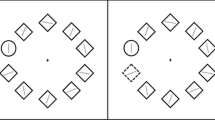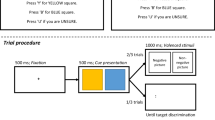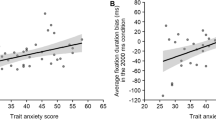Abstract
Researchers using spatial attention tasks have shown that anxious individuals are quick to orient to threatening information, but have difficulty disengaging attention from that location. We extended this line of research by investigating the influence of anxiety on attention across time rather than space. It was found that anxious words imbedded in a rapidly presented stream of distractors were correctly identified more often than neutral words, regardless of the emotional state of the participant. Having identified the first target in the stream, participants were able to detect a second target sooner when the first target was an anxious word and the participant was experiencing anxiety in comparison to conditions in which the first target was neutral or the participant was not anxious. The rapid recovery of the attentional system when there was emotional congruence between the state of the individual and the attended information, points to the unique influence that anxiety has on attention across time in comparison to its influence on spatial attention.



Similar content being viewed by others
References
Amir, N., Elias, J., Klumpp, H., & Przeworski, A. (2003). Attentional bias to threat in social phobia: Facilitated processing of threat or difficulty disengaging attention from threat? Behaviour Research and Therapy, 41(11), 1325–1335. doi:10.1016/S0005-7967(03)00039-1.
Anderson, A. K., & Phelps, E. A. (2001). Lesions of the human amygdala impair enhanced perception of emotionally salient events. Nature, 411(6835), 305–309. doi:10.1038/35077083.
Arend, I., & Botella, J. (2002). Emotional stimuli reduce the attentional blink in sub-clinical anxious subjects. Psicothema, 14(2), 209–214.
Arnell, K. M., & Jolicoeur, P. (1999). The attentional blink across stimulus modalities: Evidence for central processing limitations. Journal of Experimental Psychology: Human Perception and Performance, 25(3), 630–648. doi:10.1037/0096-1523.25.3.630.
Barnard, P. J., Ramponi, C., Battye, G., & Mackintosh, B. (2005). Anxiety and the deployment of visual attention over time. Visual Cognition, 12(1), 181–211. doi:10.1080/13506280444000139.
Bitran, S., & Barlow, D. H. (2004). Etiology and treatment of social anxiety: A commentary. Journal of Clinical Psychology, 60(8), 881–886. doi:10.1002/jclp.20045.
Bower, G. H. (1981). Mood and memory. The American Psychologist, 36(2), 129–148. doi:10.1037/0003-066X.36.2.129.
Bradley, M. M., & Lang, P. J. (1999). Affective norms for English words (ANEW). Gainsesville, FL: The NIMH Center for the Study of Emotiona and Attention, University of Florida.
Bradley, B. P., Mogg, K., Falla, S. J., & Hamilton, L. R. (1998). Attentional bias for threatening facial expressions in anxiety: Manipulation of stimulus duration. Cognition &. Emotion, 12(6), 737–753. (Washington, D.C.).
Brahms, J. (1983). Variations on a theme of Haydn for orchestra in B flat major (St. Anthony Variations), Op. 56a [Wiener Philharmoniker, conducted by Leonard Bernstein]. On Brahms: Symphonie No. 3 [CD]. Deutsche Grammophon.
Broadbent, D., & Broadbent, M. (1988). Anxiety and attentional bias: State and trait. Cognition and Emotion, 2(3), 165–183. doi:10.1080/02699938808410922.
Chun, M. M., & Potter, M. C. (1995). A two-stage model for multiple target detection in rapid serial visual presentation. Journal of Experimental Psychology: Human Perception and Performance, 21(1), 109–127. doi:10.1037/0096-1523.21.1.109.
Dalgleish, T., & Watts, F. N. (1990). Biases of attention and memory in disorders of anxiety and depression. Clinical Psychology Review, 10(5), 589–604. doi:10.1016/0272-7358(90)90098-U.
Dobson, K. S., & Kendall, P. C. (Eds.). (1993). Psychopathology and cognition. San Diego, CA, USA: Academic Press Inc.
Ehlers, A., Margraf, J., Davies, S., & Roth, W. T. (1988). Selective processing of threat cues in subjects with panic attacks. Cognition and Emotion, 2(3), 201–219. doi:10.1080/02699938808410924.
Eysenck, M. W., & Calvo, M. G. (1992). Anxiety and performance: The processing efficiency theory. Cognition and Emotion, 6(6), 409–434. doi:10.1080/02699939208409696.
Fox, E. (1994). Attentional bias in anxiety: A defective inhibition hypothesis. Cognition and Emotion, 8(2), 165–195. doi:10.1080/02699939408408934.
Fox, E., Russo, R., Bowles, R., & Dutton, K. (2001). Do threatening stimuli draw or hold visual attention in subclinical anxiety? Journal of Experimental Psychology: General, 130(4), 681–700. doi:10.1037/0096-3445.130.4.681.
Kucera, H., & Francis, W. N. (1967). Computational analysis of present-day American English. Providence: Brown University Press.
Lang, P. J., Bradley, M. M., & Cuthbert, B. N. (1999). International affective picture system (IAPS) technical manual and affective ratings. Gainesville, FL: The Center for Research in Psychophysiology, University of Florida.
Ligeti, G. (1996). String quartet No. 1 (Metamophoses nocturnes) [Arditti String Quartet]. On Ligeti: String Quartets and Duets [CD]. Sony.
Luck, S. J., & Vogel, E. K. (2001). Multiple sources of interference in dual-task performance: The cases of the attentional blink and the psychological refractory period. In K. Shapiro (Ed.), The limits of attention: Temporal constraints in human information processing (pp. 124–140). London: Oxford University Press.
Luck, S. J., Vogel, E. K., & Shapiro, K. L. (1996). Word meanings can be accessed but not reported during the attentional blink. Nature, 383(6601), 616–618. doi:10.1038/383616a0.
MacLeod, C. (1999). Anxiety and anxiety disorders. In T. Dalgleish & M. J. Power (Eds.), Handbook of cognition and emotion (pp. 447–477). New York, NY: John Wiley & Sons Ltd.
MacLeod, C., Mathews, A., & Tata, P. (1986). Attentional bias in emotional disorders. Journal of Abnormal Psychology, 95(1), 15–20. doi:10.1037/0021-843X.95.1.15.
Mattia, J. I., Heimberg, R. G., & Hope, D. A. (1993). The revised Stroop color-naming task in social phobics. Behaviour Research and Therapy, 31(3), 305–313. doi:10.1016/0005-7967(93)90029-T.
McNally, R. J., Kaspi, S. P., Riemann, B. C., & Zeitlin, S. B. (1990a). Selective processing of threat cues in posttraumatic stress disorder. Journal of Abnormal Psychology, 99(4), 398–402. doi:10.1037/0021-843X.99.4.398.
McNally, R. J., Riemann, B. C., & Kim, E. (1990b). Selective processing of threat cues in panic disorder. Behaviour Research and Therapy, 28(5), 407–412. doi:10.1016/0005-7967(90)90160-K.
Mineka, S., & Gilboa, E. (1998). Cognitive biases in anxiety and depression. In W. F. Flack Jr. & J. D. Laird (Eds.), Emotions in psychopathology: Theory and research. Series in affective science (pp. 216–228). New York, NY, USA: Oxford University Press.
Mogg, K., & Bradley, B. P. (1999). Orienting of attention to threatening facial expressions presented under conditions of restricted awareness. Cognition and Emotion, 13(6), 713–740. doi:10.1080/026999399379050.
Mogg, K., Bradley, B. P., & Hallowell, N. (1994). Attentional bias to threat: Roles of trait anxiety, stressful events, and awareness. The Quarterly Journal of Experimental Psychology. A: Human Experimental Psychology, 47A(4), 841–864.
Nicholls, M. E. R., Schier, M., Stough, C. K. K., & Box, A. (1999). Psychophysical and electrophysiologic support for a left hemisphere temporal processing advantage. Neuropsychiatry, Neuropsychology, and Behavioral Neurology, 12(1), 11–16.
Niedenthal, P. M., Halberstadt, J. B., & Setterlund, M. B. (1997). Being happy and seeing “happy”: Emotional state mediates visual word recognition. Cognition and Emotion, 11(4), 403–432. doi:10.1080/026999397379863.
Oehman, A., Flykt, A., & Esteves, F. (2001). Emotion drives attention: Detecting the snake in the grass. Journal of Experimental Psychology: General, 130(3), 466–478. doi:10.1037/0096-3445.130.3.466.
Okubo, M., & Nicholls, M. E. R. (in press). Hemispheric asymmetries for temporal information processing: Transient detection versus sustained monitoring. Brain and Cognition.
Psychology Software Tools. (1999). E-prime: Verson 1.1. Pittsburgh, PA: Psychology Software Tools.
Raymond, J. E., Shapiro, K. L., & Arnell, K. M. (1992). Temporary suppression of visual processing in an RSVP task: An attentional blink? Journal of Experimental Psychology: Human Perception and Performance, 18(3), 849–860. doi:10.1037/0096-1523.18.3.849.
Russell, J. A., Weiss, A., & Mendelsohn, G. A. (1989). Affect Grid: A single-item scale of pleasure and arousal. Journal of Personality and Social Psychology, 57(3), 493–502. doi:10.1037/0022-3514.57.3.493.
Shapiro, K. L. (1994). The attentional blink: The brain’s “eyeblink.”. Current Directions in Psychological Science, 3(3), 86–89. doi:10.1111/1467-8721.ep10770436.
Shapiro, K. L. (2001). The limits of attention: Temporal constraints in human information processing. London: Oxford University Press.
Snodgrass, J. G., & Corwin, J. (1988). Pragmatics of measuring recognition memory: Applications to dementia and amnesia. Journal of Experimental Psychology: General, 117(1), 34–50. doi:10.1037/0096-3445.117.1.34.
Storbeck, J., & Robinson, M. D. (2004). Preferences and inferences in encoding visual objects: A systematic comparison of semantic and affective priming. Personality and Social Psychology Bulletin, 30(1), 81–93. doi:10.1177/0146167203258855.
Watson, D., & Clark, L. A. (1999). The PANAS-X. Manual for the positive and negative affect schedule - expanded form. Iowa City, IA: The University of Iowa.
Acknowledgements
We would like to thank Kevin Krogstad and Michael Scarski for their help in data collection. This manuscript is based on a Thesis written by the first author, under the direction of the second author, in partial fulfillment of the requirements for the Master of Science degree at North Dakota State University.
Author information
Authors and Affiliations
Corresponding author
Additional information
Portions of this manuscript were presented at the 41st Annual Convention of the Association for Behavioral and Cognitive Therapies, 2007, Philadelphia, PA.
Rights and permissions
About this article
Cite this article
Lystad, C.M., Rokke, P.D. & Stout, D.M. Emotion Congruent Facilitation of Attention when Processing Anxious Stimuli. Cogn Ther Res 33, 499–510 (2009). https://doi.org/10.1007/s10608-008-9210-1
Received:
Accepted:
Published:
Issue Date:
DOI: https://doi.org/10.1007/s10608-008-9210-1




